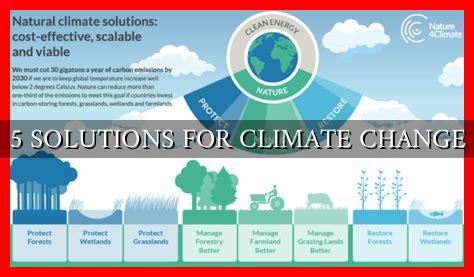-
Table of Contents
5 SOLUTIONS FOR CLIMATE CHANGE
Climate change is one of the most pressing issues facing our planet today. With rising global temperatures, melting ice caps, and extreme weather events becoming more frequent, it is crucial that we take action to mitigate the effects of climate change. In this article, we will explore five solutions that can help combat climate change and create a more sustainable future for generations to come.
1. Transition to Renewable Energy Sources
One of the biggest contributors to climate change is the burning of fossil fuels for energy. This releases greenhouse gases such as carbon dioxide into the atmosphere, trapping heat and causing global temperatures to rise. Transitioning to renewable energy sources, such as solar, wind, and hydroelectric power, can help reduce our reliance on fossil fuels and lower carbon emissions.
- According to the International Energy Agency, renewable energy sources accounted for almost 30% of global electricity generation in 2020.
- Denmark is a leader in renewable energy, with wind power supplying over 50% of its electricity needs.
By investing in renewable energy infrastructure and technology, we can create a more sustainable energy system that will help combat climate change.
2. Increase Energy Efficiency
Another way to reduce carbon emissions and combat climate change is to increase energy efficiency in our homes, buildings, and transportation systems. By using energy-efficient appliances, improving insulation, and investing in public transportation, we can reduce our energy consumption and lower our carbon footprint.
- The Energy Star program estimates that Americans saved $30 billion on utility bills in 2020 by using energy-efficient products.
- Germany has implemented energy efficiency measures that have helped reduce its carbon emissions by over 30% since 1990.
By prioritizing energy efficiency, we can reduce our impact on the environment and help slow the effects of climate change.
3. Protect and Restore Ecosystems
Ecosystems such as forests, wetlands, and coral reefs play a crucial role in regulating the Earth’s climate. By protecting and restoring these ecosystems, we can help sequester carbon dioxide from the atmosphere and preserve biodiversity.
- The Amazon rainforest, often referred to as the “lungs of the Earth,” absorbs an estimated 2 billion tons of carbon dioxide each year.
- The Great Barrier Reef in Australia is home to thousands of species and provides valuable ecosystem services, such as coastal protection and tourism revenue.
By investing in conservation efforts and sustainable land management practices, we can protect and restore ecosystems that are vital for combating climate change.
4. Implement Carbon Pricing
Carbon pricing is a market-based mechanism that puts a price on carbon emissions, incentivizing businesses and individuals to reduce their carbon footprint. By internalizing the cost of carbon pollution, carbon pricing can help drive investment in clean technologies and encourage sustainable practices.
- Sweden implemented a carbon tax in 1991, which has helped reduce its carbon emissions by over 25% while maintaining economic growth.
- The European Union’s Emissions Trading System is the world’s largest carbon market, covering over 40% of the EU’s greenhouse gas emissions.
By implementing carbon pricing mechanisms, we can create economic incentives for reducing carbon emissions and transitioning to a low-carbon economy.
5. Support Climate Resilience and Adaptation
As the effects of climate change become more severe, it is essential to support climate resilience and adaptation efforts to protect vulnerable communities and ecosystems. By investing in infrastructure, early warning systems, and disaster preparedness, we can help communities adapt to the impacts of climate change and build resilience for the future.
- The Green Climate Fund provides financial support to developing countries for climate adaptation and mitigation projects.
- The city of Rotterdam in the Netherlands has implemented innovative flood protection measures to adapt to rising sea levels and increased rainfall.
By supporting climate resilience and adaptation initiatives, we can help communities prepare for the challenges of a changing climate and build a more sustainable future for all.
Summary
Climate change is a global challenge that requires urgent action. By transitioning to renewable energy sources, increasing energy efficiency, protecting and restoring ecosystems, implementing carbon pricing, and supporting climate resilience and adaptation, we can work together to combat climate change and create a more sustainable future for generations to come. It is essential that individuals, businesses, and governments around the world take proactive steps to address climate change and build a more resilient and sustainable world.





